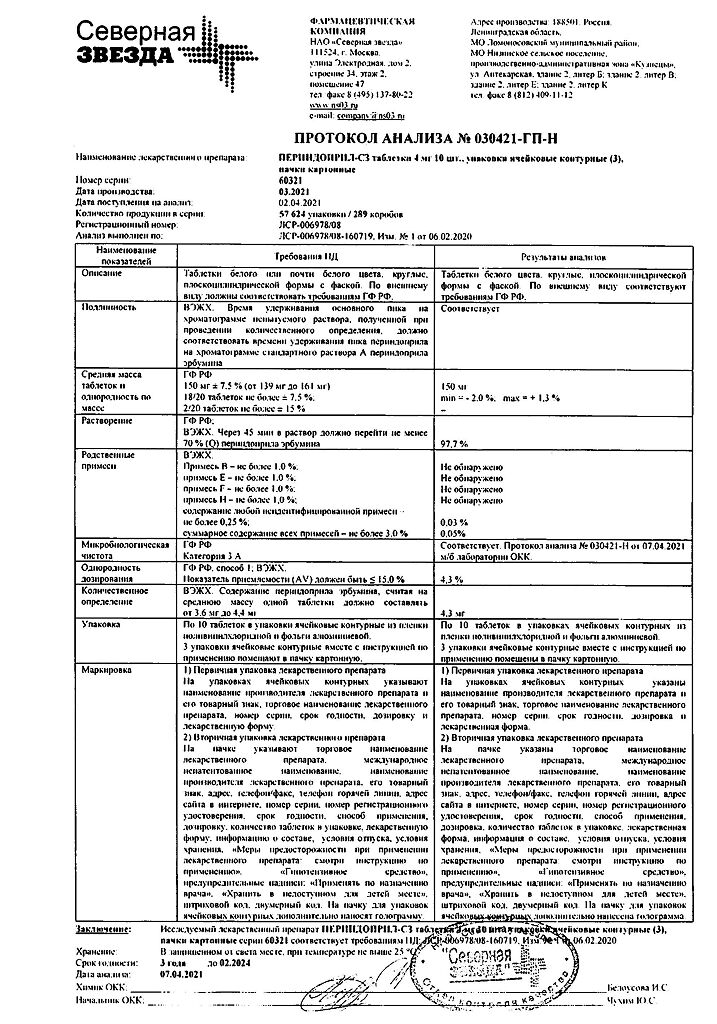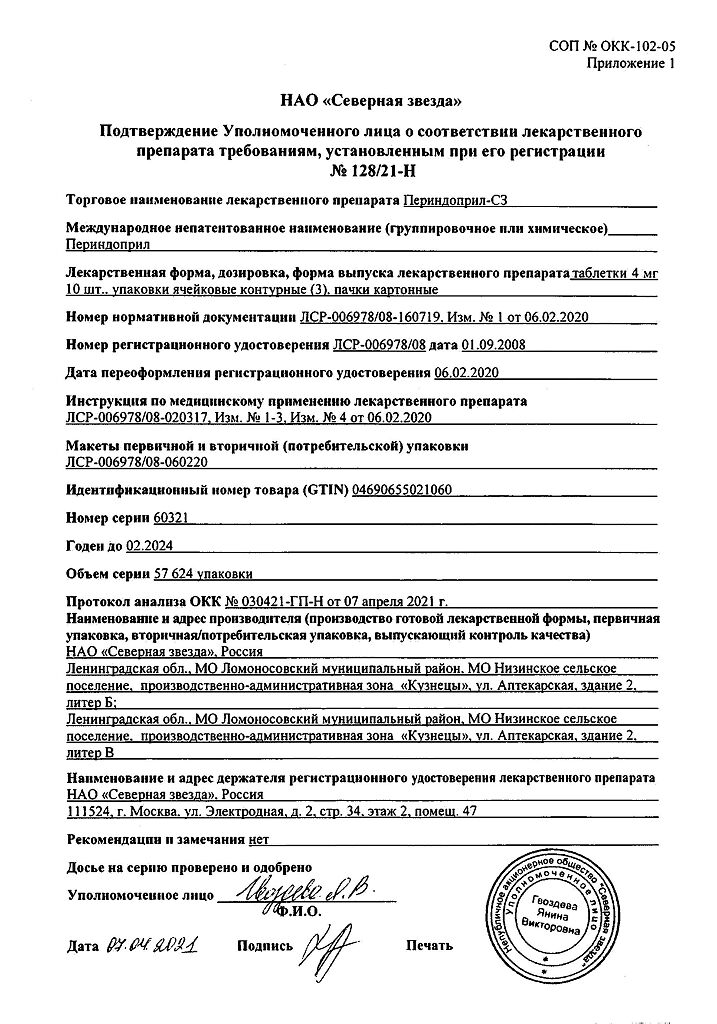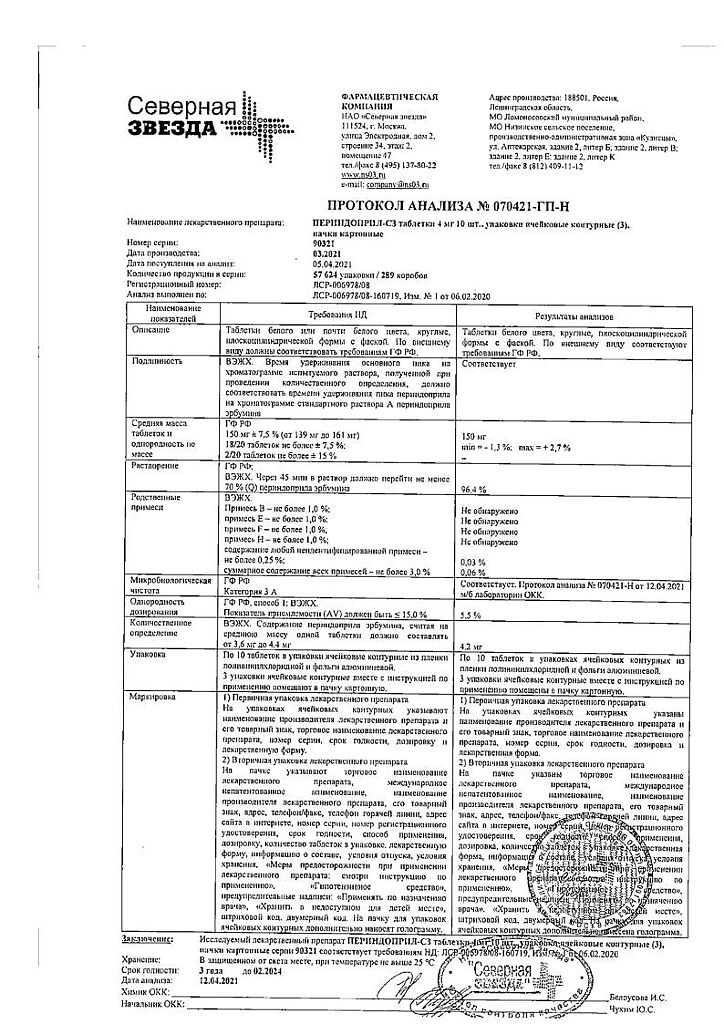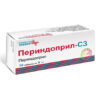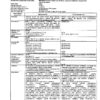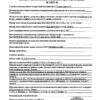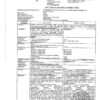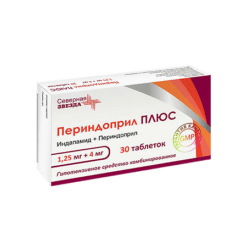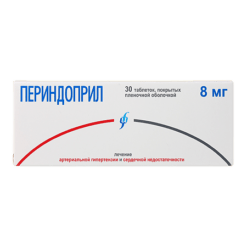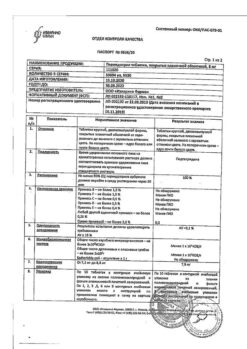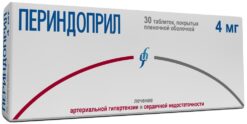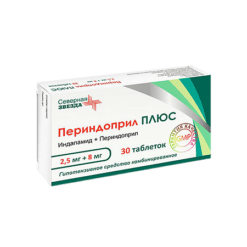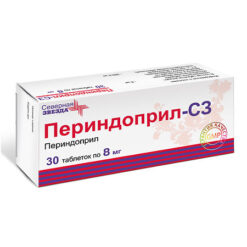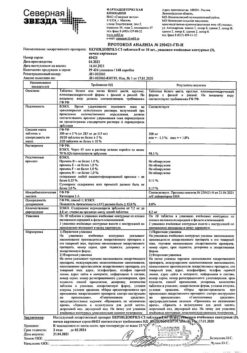No products in the cart.
Perindopril-SZ, tablets 4 mg 30 pcs
€5.37 €4.77
Description
Pharmacotherapeutic group:
An angiotensin-converting enzyme inhibitor (ACE).
The ATX code: [C09AA04].
Pharmacological properties.
Pharmacodynamics.
The ACE inhibitor. Suppression of ACE leads to a decrease in plasma angiotensin II, resulting in a decrease in aldosterone secretion. Perindopril acts through its active metabolite perindoprilat.
Corrects the vasoconstrictor effect of angiotensin II, increases the concentration of bradykinin and vasodilator prostaglandins (ACE converts inactive angiotensin I into angiotensin II with vasoconstrictor effect and also causes degradation of bradykinin and prostaglandin with vasodilator activity); reduces the production and release of aldosterone, suppresses the release of norepinephrine from the sympathetic nerve fiber endings and the formation of endothelin in the vascular wall. Decrease of angiotensin II formation is accompanied by increase of plasma renin activity (due to inhibition of negative feedback).
The suppression of ACE is accompanied by increased activity of both circulating and tissue kallikrein-kinin system, while the prostaglandin system is also activated. It promotes restoration of elasticity of large arterial vessels (decrease of formation of excessive amount of subendothelial collagen), reduces pressure in pulmonary capillaries, with long-term prescription it reduces severity of left ventricular myocardial hypertrophy and interstitial fibrosis, normalizes myosin isoenzyme profile; normalizes heart function.
Limits preload and postload (reduces systolic and diastolic blood pressure in the “lying” and “standing” position), the filling pressure of the left and right ventricles, total peripheral vascular resistance; increases the minute circulatory volume and cardiac index without changing the heart rate (in patients with chronic heart failure), does not increase the heart rate, increases regional blood flow in the muscles.
increases the concentration of high-density lipoproteins, in patients with hyperuricemia reduces the concentration of uric acid. Increases renal blood flow, does not change glomerular filtration rate. in patients with chronic heart failure causes significant reduction of clinical signs of heart failure, increases exercise tolerance (by ergometer testing), does not significantly reduce blood pressure.
After oral administration of an average single dose the maximal hypotensive effect is reached after 4-6 hours and is maintained during 24 hours. Stabilization of hypotensive effect is observed after 1 month of therapy and is maintained for a long time. Discontinuation of treatment is not accompanied by development of “withdrawal” syndrome.
Pharmacokinetics.
Absorption – 25%, bioavailability – 65-70%. Time of reaching maximum concentration in blood plasma – 1 hour, perindoprilat – 3-4 hours. During metabolism 20% is transformed into active metabolite – perindoprilat (taking perindopril after meals reduces the proportion of perindoprilat formed – significant clinical significance); the remaining amount – into 5 inactive compounds. T1/2 (elimination half-life) of perindopril is 1 hour.
Binding of perindoprilat with blood plasma proteins is insignificant, with ACE – less than 30% (it depends on concentration). Distribution volume of free perindoprilat is 0.2 l/kg. Perindoprilat is excreted by the kidneys, T1/2 of free metabolite fraction is 3-5 hours. Dissociation of perindoprilat bound to ACE is slow. Due to this “effective” T1/2 is 25 h.
The repeated administration of perindopril does not result in its cumulation, and the T1/2 of perindoprilat when repeatedly administered corresponds to its period of activity. Excretion of perindoprilat is slower in elderly patients, as well as in patients with chronic heart failure and chronic renal failure (in the latter the dose should be adjusted depending on creatinine clearance).
The dialysis clearance of perindopril is 70 ml/min. In patients with cirrhosis, hepatic clearance of perindopril is reduced by half, while the total amount of perindoprilate produced does not change and dosing regimen adjustment is not required.
Indications
Indications
Arterial hypertension, chronic heart failure.
Pharmacological effect
Pharmacological effect
Pharmacotherapeutic group:
angiotensin-converting enzyme inhibitor (ACE inhibitor).
ATX code: [C09AA04].
Pharmacological properties.
Pharmacodynamics.
ACE inhibitor. Suppression of ACE leads to a decrease in the content of angiotensin II in the blood plasma, as a result of which the secretion of aldosterone decreases. Perindopril acts through its active metabolite perindoprilate.
Eliminates the vasoconstrictor effect of angiotensin II, increases the concentration of bradykinin and vasodilator prostaglandins (ACE converts inactive angiotensin I into angiotensin II, which has a vasoconstrictor effect, and also causes degradation of bradykinin and prostaglandin, which have vasodilatory activity); reduces the production and release of aldosterone, suppresses the release of norepinephrine from the endings of sympathetic nerve fibers and the formation of endothelin in the vascular wall. A decrease in the formation of angiotensin II is accompanied by an increase in plasma renin activity (due to inhibition of negative feedback).
Suppression of ACE is accompanied by an increase in the activity of both the circulating and tissue kallikrein-kinin system, while the prostaglandin system is also activated. Helps restore the elasticity of large arterial vessels (reducing the formation of excess subendothelial collagen), reduces pressure in the pulmonary capillaries, with long-term administration reduces the severity of left ventricular myocardial hypertrophy and interstitial fibrosis, normalizes the myosin isoenzyme profile; normalizes heart function.
Reduces preload and afterload (reduces systolic and diastolic blood pressure in the “lying” and “standing” positions), filling pressure of the left and right ventricles, total peripheral vascular resistance; increases minute volume of blood circulation and cardiac index without changing heart rate (in patients with chronic heart failure), does not increase heart rate, and increases regional blood flow in the muscles.
Increases the concentration of high-density lipoproteins; in patients with hyperuricemia, reduces the concentration of uric acid. Increases renal blood flow, does not change the glomerular filtration rate. In patients with chronic heart failure, it causes a significant decrease in the severity of clinical signs of heart failure, increases exercise tolerance (according to the bicycle ergometer test), and does not significantly reduce blood pressure.
After oral administration of an average single dose, the maximum hypotensive effect is achieved after 4-6 hours and persists for 24 hours. Stabilization of the hypotensive effect is observed after 1 month of therapy and persists for a long time. Termination of treatment is not accompanied by the development of withdrawal syndrome.
Pharmacokinetics.
Absorption – 25%, bioavailability – 65-70%. The time to reach the maximum concentration in the blood plasma is 1 hour, perindoprilate – 3-4 hours. During metabolism, 20% is transformed into the active metabolite – perindoprilat (taking perindopril after meals reduces the proportion of perindoprilate formed – has no significant clinical significance); the remaining amount is 5 inactive compounds. T1/2 (half-life) of perindopril – 1 hour
The association of perindoprilate with plasma proteins is insignificant, with ACE – less than 30% (depending on the concentration). The volume of distribution of free perindoprilate is 0.2 l/kg. Perindoprilat is excreted by the kidneys, T1/2 of the free metabolite fraction is 3-5 hours. The dissociation of perindoprilat associated with ACE is slow. As a result, the “effective” T1/2 is 25 hours.
Repeated administration of perindopril does not lead to its accumulation, and T1/2 of perindoprilat upon repeated administration corresponds to the period of its activity. The elimination of perindoprilate slows down in elderly patients, as well as in patients with chronic heart failure and chronic renal failure (in the latter, dose adjustment should be made depending on creatinine clearance).
The dialysis clearance of perindopril is 70 ml/min. In patients with liver cirrhosis, the hepatic clearance of perindopril is reduced by 2 times, while the total amount of perindoprilate formed does not change and no adjustment of the dosage regimen is required.
Special instructions
Special instructions
The risk of developing arterial hypotension and/or renal failure while taking the drug increases with significant loss of sodium and water (strict salt-free diet, and/or taking diuretics, diarrhea, vomiting) or renal artery stenosis (blockade of the renin-angiotensin system in these situations can lead, especially when first taking the drug and during the first 2 weeks of treatment, to a sudden decrease in blood pressure and the development of chronic renal failure).
Before starting and during therapy, it is recommended to determine the concentration of creatinine, electrolytes and urea (within 1 month). In patients with arterial hypertension already receiving diuretic therapy, it is necessary to stop taking them (3 days before starting Perindopril) and, if necessary, add them to treatment again in the future.
In patients with chronic heart failure receiving diuretic therapy, if possible, their dose should also be reduced several days before starting treatment. In patients at risk, especially with chronic heart failure in the stage of decompensation, elderly patients, as well as patients with initially low blood pressure, impaired renal function or receiving large doses of diuretics, the initiation of the drug should be monitored.
In patients undergoing hemodialysis, the use of polyacrylonitrile membranes should be avoided (the development of anaphylactoid reactions is possible). It is necessary to stop taking it 12 hours before the upcoming surgical treatment and notify the anesthesiologist about taking the drug.
Impact on the ability to drive a car and perform work that requires increased attention.
Due to the risk of developing arterial hypotension and dizziness, ACE inhibitors should be prescribed with caution to persons driving vehicles and engaging in activities that require increased attention and rapid motor response.
Active ingredient
Active ingredient
Perindopril
Composition
Composition
1 tablet contains the active ingredient:
Contraindications
Contraindications
Hypersensitivity to perindopril and other components of the drug or other ACE inhibitors, a history of angioedema during therapy with inhibitors. ACE, hereditary or idiopathic angioedema, pregnancy, lactation, age under 18 years (efficacy and safety have not been established).
Side Effects
Side Effects
– From the cardiovascular system: often – excessive decrease in blood pressure and associated symptoms, rarely – arrhythmia, angina pectoris, myocardial infarction and stroke.
Interaction
Interaction
When used simultaneously with antihypertensive drugs, muscle relaxants, and anesthetic agents, the antihypertensive effect may be enhanced.
When used simultaneously with loop diuretics and thiazide diuretics, the antihypertensive effect may be enhanced. Severe arterial hypotension, especially after taking the first dose of a diuretic, apparently occurs due to hypovolemia, which leads to a transient increase in the hypotensive effect of perindopril. The risk of kidney dysfunction increases.
When used simultaneously with sympathomimetics, the antihypertensive effect of perindopril may be reduced.
When used simultaneously with tricyclic antidepressants and antipsychotics (neuroleptics), the risk of developing postural hypotension increases.
When used simultaneously with indomethacin, the antihypertensive effect of perindopril is reduced, apparently due to inhibition of prostaglandin synthesis under the influence of NSAIDs (which are believed to play a role in the development of the hypotensive effect of ACE inhibitors).
When used simultaneously with insulin, hypoglycemic agents and sulfonylurea derivatives, hypoglycemia may develop due to increased glucose tolerance.
When used simultaneously with potassium-sparing diuretics (including spironolactone, triamterene, amiloride), potassium preparations, salt substitutes and dietary supplements containing potassium, hyperkalemia may develop (especially in patients with impaired renal function), because ACE inhibitors reduce the content of aldosterone, which leads to potassium retention in the body while limiting the excretion of potassium or its additional intake into the body.
When used simultaneously with lithium carbonate, it is possible to reduce the excretion of lithium from the body.
Overdose
Overdose
Symptoms: marked decrease in blood pressure, shock, stupor, bradycardia, electrolyte disturbances (hyperkalemia, hyponatremia), renal failure.
Storage conditions
Storage conditions
List B. In a dry place, protected from light, at a temperature not exceeding 25°C.
Shelf life
Shelf life
2 years. Do not use after the date indicated on the package.
Manufacturer
Manufacturer
North Star NAO, Russia
Additional information
| Shelf life | 2 years. Do not use later than the date on the package. |
|---|---|
| Conditions of storage | List B. In a dry, light-protected place at a temperature not exceeding 25°C. |
| Manufacturer | North Star NAO, Russia |
| Medication form | pills |
| Brand | North Star NAO |
Other forms…
Related products
Buy Perindopril-SZ, tablets 4 mg 30 pcs with delivery to USA, UK, Europe and over 120 other countries.


